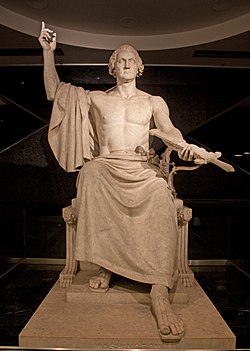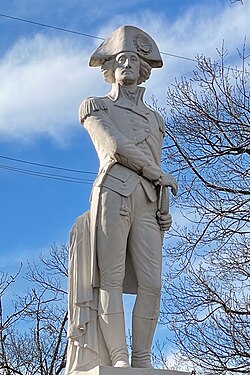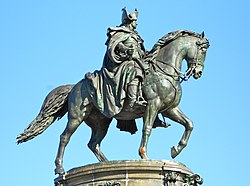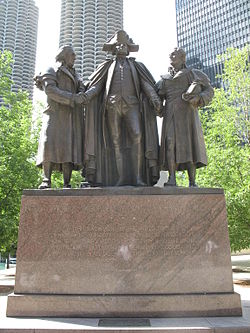| Image | Article | Location | Date | Sculptor | Notes |
|---|
 | Statue of George Washington | Richmond, Virginia
Virginia State Capitol | 1791–1792 | Jean-Antoine Houdon | marble statue, has numerous bronze copies by Hubard and Gorham |
 | Statue of George Washington | Philadelphia, Pennsylvania
Pennsylvania Academy of Fine Arts | 1815 | William Rush | wooden statue, relocated in 1824 to Independence Hall, now at the Second Bank of the United States |
 | George Washington | Raleigh, North Carolina
North Carolina State House | 1820 | Antonio Canova | destroyed by fire on June 21, 1831 |
 | George Washington | Raleigh, North Carolina
North Carolina Museum of History | 1910 | Antonio Canova | plaster replica of the 1820 statue |
 | George Washington | Raleigh, North Carolina
North Carolina State Capitol | 1970 | Antonio Canova | marble copy by Romano Vio of the 1820 statue |
 | Statue of George Washington | Boston, Massachusetts
Massachusetts State House | 1826 | Francis Chantrey | |
 | Washington Monument | Baltimore, Maryland
Mount Vernon Place & Washington Place | 1829 | Enrico Causici | marble statue atop the monument designed by architect Robert Mills |
 | George Washington | Washington, D.C.
National Museum of American History | 1840 | Horatio Greenough | marble statue first shown in the United States Capitol rotunda |
 | Statue of George Washington | Washington, D.C.
Smithsonian American Art Museum | 1841 c. 1841 | Ferdinand Pettrich | plaster statue painted bronze |
 | Equestrian statue of George Washington | New York City, New York
Union Square | 1856 | Henry Kirke Brown | |
 | George Washington | Baltimore, Maryland
Druid Hill Park | 1857 | Edward Sheffield Bartholomew | |
 | Virginia Washington Monument | Richmond, Virginia
Capitol Square | 1858–1869 | Thomas Crawford and Randolph Rogers | |
 | Lieutenant General George Washington | Washington, D.C.
Washington Circle | 1860 | Clark Mills | |
 | Statue of George Washington | Philadelphia, Pennsylvania
Independence Hall | 1869 | Joseph A. Bailly | marble statue, now at Philadelphia City Hall |
 | Statue of George Washington | Philadelphia, Pennsylvania
Independence Hall | 1910 | Joseph A. Bailly | bronze replica of the 1869 statue |
 | Equestrian statue of George Washington | Boston, Massachusetts
Boston Public Garden | 1869 | Thomas Ball | |
 | Statue of George Washington | Trenton, New Jersey
Douglass House, Mill Hill | 1876 c. 1876 | Fratelli Gianfranchi | first displayed at the Centennial Exposition of 1876 in Philadelphia |
 | Statue of George Washington | Newburyport, Massachusetts | 1878 | John Quincy Adams Ward | |
 | Statue of George Washington | New York City, New York
Federal Hall | 1883 | John Quincy Adams Ward | |
 | Washington Monument | Milwaukee, Wisconsin
Milwaukee Central Library | 1885 | Richard Henry Park | |
 | Statue of George Washington | Newburgh, New York
Tower of Victory, Washington's Headquarters State Historic Site | 1887 | William Rudolf O'Donovan | plaster model painted bronze at the Smithsonian American Art Museum |
 | Statue of George Washington | Trenton, New Jersey
Trenton Battle Monument | 1893 | William Rudolf O'Donovan | bronze statue atop the monument designed by architect John H. Duncan |
 | Statue of George Washington | Perth Amboy, New Jersey
Market Square, Perth Amboy City Hall | 1896 | Nels N. Alling | terra cotta statue, dedicated on February 22, 1896 |
 | Equestrian statue of George Washington | Philadelphia, Pennsylvania
Eakins Oval | 1897 | Rudolf Siemering | bronze statue atop the Washington Monument |
 | Statue of George Washington | Seattle, Washington
University of Washington | 1909 | Lorado Taft | |
 | Equestrian statue of George Washington | Newark, New Jersey
Washington Park | 1912 | J. Massey Rhind | |
 | Washington Monument | West Point, New York
United States Military Academy | 1916 | Henry Kirke Brown | |
 | Statue of George Washington | Washington Crossing, Pennsylvania
Washington Crossing Historic Park | 1916 | Unknown | granite statue atop the Washington Crossing Monument |
 | Princeton Battle Monument | Princeton, New Jersey
New Jersey Route 27 | 1922 | Frederick William MacMonnies and Thomas Hastings | |
 | Statue of George Washington | Portland, Oregon
German American Society Building | 1926–1927 | Pompeo Coppini | |
 | Equestrian statue of George Washington | Morristown, New Jersey
Washington's Headquarters | 1927–1928 | Frederick Roth | |
 | Heald Square Monument | Chicago, Illinois
Heald Square | 1936-1941 | Lorado Taft and Leonard Crunelle | |
 | Statue of George Washington | Alexandria, Virginia
George Washington Masonic National Memorial | 1949 | Bryant Baker | bronze statue entitled Illustrious Brother George Washington, dedicated on February 22, 1950 |
 | Statue of George Washington | Austin, Texas
University of Texas at Austin | 1955 | Pompeo Coppini | |
 | Tomb of the Unknown Revolutionary War Soldier | Philadelphia, Pennsylvania
Washington Square | 1957 | Jean-Antoine Houdon and G. Edwin Brumbaugh | |
 | George Washington on Horseback | Washington, D.C.
Washington National Cathedral | 1959 | Herbert Haseltine | |
 | Statue of George Washington | Indianapolis, Indiana
Indiana Statehouse | 1959 | Donald De Lue | |
| Point of View | Pittsburgh, Pennsylvania
Point of View Park | 2006 | James A. West | |










































